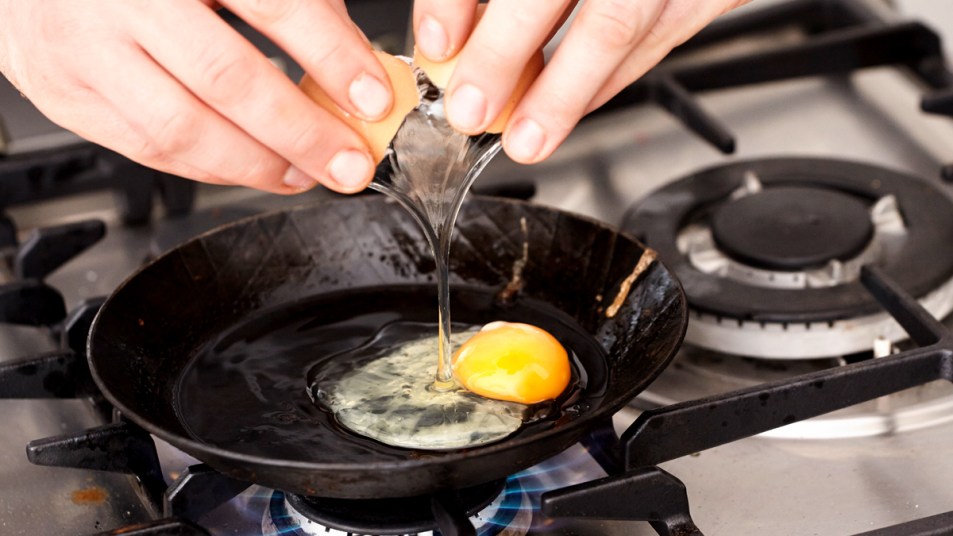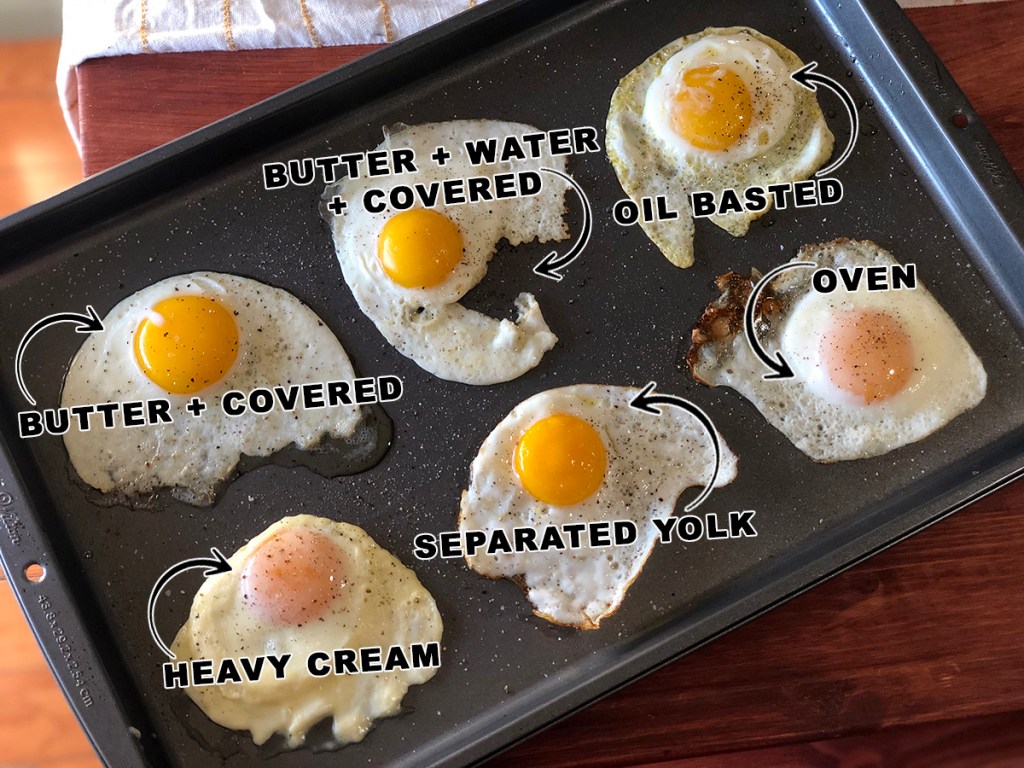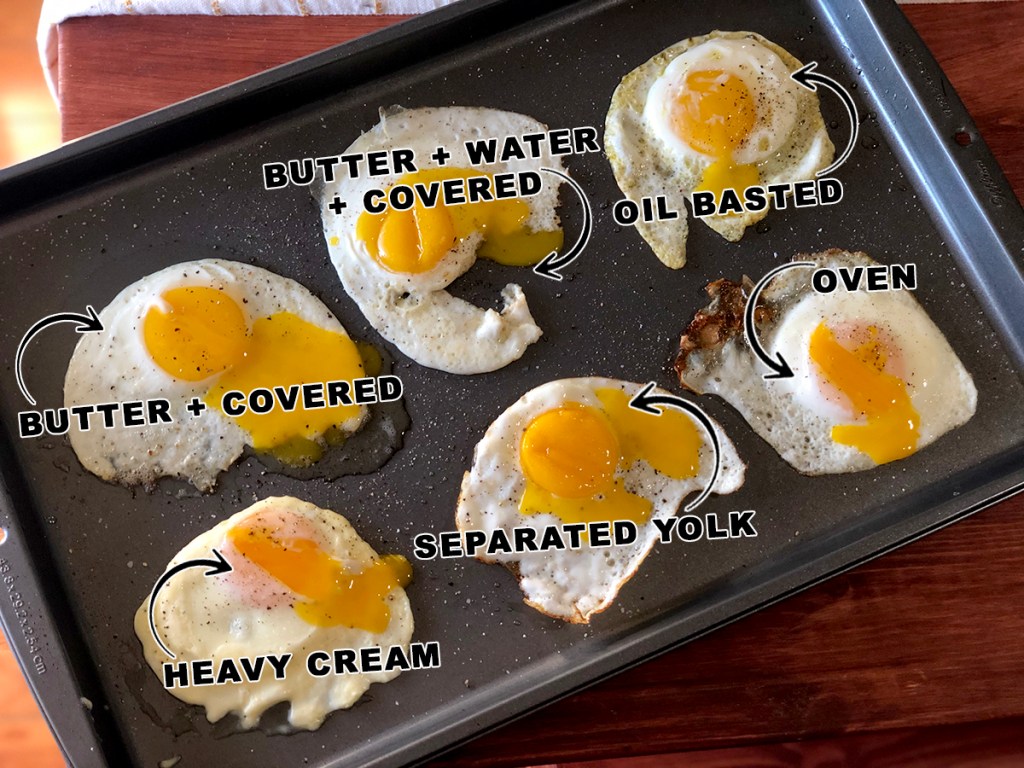I Tried 6 Tricks for Perfect Fried Eggs and 1 Stood Out from the Rest
We aren't yolking around — the best trick for fried eggs is totally easy.

There are countless dishes you can plop a fried egg on top of to add an extra layer of delicious flavor. I’m a big fan of adding them to things like burgers, pasta, pizza, and even savory breakfast nachos. And it’s obviously great on just a piece of toast for a simple and nutritious start to the day. Some folks might prefer their fried eggs with set yolks cooked over hard or medium, but I personally love them sunny-side side up (no flipping required!) with the perfect balance of set whites and a slightly runny yolk — which can sometimes be annoyingly difficult to achieve.
Judging by the hundreds of articles I found after searching “best way to fry an egg,” I am clearly not the only person struggling with this issue. If combing through all of that advice sounds daunting, don’t worry — I did it for you! More specifically, I narrowed in on six methods that seemed the most promising and gave them all a try.

(The eggs weren’t cooked on this baking sheet, I just wanted something big enough to spread them all out on for display.)
How to Fry Eggs in Butter with a Covered Pan
My first technique is from Delish and it was definitely the easiest: Heat a tablespoon of butter in a pan, crack the egg in, then cover with a lid for for a couple minutes. It worked pretty well, but it was kind of difficult to tell when the whites had set with the lid in the way. Using that much butter also created a hefty puddle once I plated the egg. Now, I’m not usually complain about too much butter, but this was a bit excessive for me. If you’re a bigger butter fan, though, this might become your personal favorite method.
How to Fry Eggs with Water and a Covered Pan
Next up was advice from Lucinda Scala Quinn, one of the top chefs on Martha Stewart’s team. It was a lot like the first egg, but with just half a tablespoon of butter and the crucial addition of a splash of water before covering. The water is supposed to help steam the whites quickly so that they set nicely before over-cooking the yolk. The egg didn’t make the prettiest shape in my pan, but the lack of a butter puddle and slightly crispy edges made this an early contender for overall best egg frying method.
How to Fry Eggs in Olive Oil
Bon Appétit provided my third method. This time, I swapped the butter for olive oil — and lots of it, enough to fully coat the bottom of the pan. After cracking the egg into the oil, I followed BA’s advice to use a spoon and baste the egg whites with the hot oil (carefully avoiding the yolk). I’m not sure if I went a little overboard on the oil, but the amount completely soaked through the whites of my egg as it cooked. It also made me fear for my skin with tons of oil popping and splattering out of the pan. It did cook the egg well, but I don’t like the idea of potential oil burns in the pursuit of any dish. It tasted fine despite the extra oil.
How to Fry Eggs in Heavy Cream
The next trick was the one I was most excited to try: Cooking the egg in heavy cream. The Kitchn recently highlighted this tip from food blogger H. Alexander Talbot. It might sound bizarre, but that’s what made me so curious to try it in the first place. Talbot’s recipe doesn’t specify how much cream to use, so I just poured enough to cover the bottom of my pan and cracked the egg on top. It took a bit longer to cook than my previous methods (about four or five minutes instead of one or two), but it got the job done with a rich, luxurious flavor. The only drawback? Having to clean out the residual cream left in the pan after plating the egg.
How to Fry Egg Whites Before Yolk
This technique from British chef Izy Hossack was by far the strangest sounding advice. According to her blog, she stumbled upon it by accident when one of her eggs happened to crack in a way that left the yolk inside the shell and allowed the white cooked on the pan by itself at first. I had to separate my egg myself, but I added the whites first and, once they were almost totally opaque, tossed the yolk on top, too. I ended up letting this sit in the pan for longer than I usually would have when the whites seemed fully set, but the yolk still looked raw. I (very delicately) touched the top of the yolk a few times to feel if it was warming up, then took it off when it finally seemed to be cooked. I’ll be honest, I was kind of scared to actually taste test this method after plating it up… Luckily, it didn’t poison me, but also didn’t have the best texture. It was a tad too gooey.
How to Fry Eggs in an Oven
This method was a bit silly for just one lonely li’l egg, but I was determined to give every technique a shot. I followed Food Network’s advice to heat my oven to 425 degrees Fahrenheit, then place a generously oiled-up baking sheet inside on its own to warm up for 15 minutes, then crack the egg onto it and put it back into the oven for another five minutes. Obviously, this took the longest amount of time to cook, but I can see it coming in handy when you’re wanting to whip up a whole dozen for your family or friends. It tasted lovely, especially since it got extra-crispy on one side. Plus, how cute is an egg with a corner?

The Best Way to Fry an Egg
After all of that, which method would I recommend as the very best? As you can see above, they all had that level of runny-yolk I was looking for with set whites. They mostly tasted great (yes, even the one with the separated yolk), but this was about finding the perfect fried egg technique.
For me, that title goes to cooking queen Martha Stewart’s team with the butter, water, and covered pan. It was quick, easy, and didn’t cause me to fear for my health or safety. I do have to give an honorable mention to the heavy cream method, though. It was a truly luxurious flavor for something as simple as a fried egg, but probably one I’ll save for special breakfast occasions, like a new Christmas morning tradition! And again, I definitely recommend the oven for larger batches of eggs.
Go ahead give these methods a try yourself and see if you agree with my results. Stoves, ovens, and palates are different, of course, so there’s a chance you might swear by one of the techniques I’ll never touch again (looking at you, scary olive oil). Whatever you go with, you’ll be making an eggs-ellent addition to your meal.
















